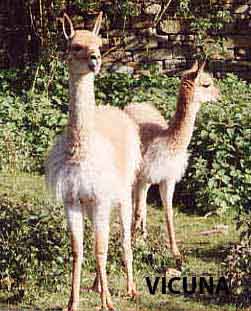|
|
|
PEACE OF YARN FIBERS
VICUNA, GUANACO, & MORE!
 |
 |
I have finally been able to get some Vicuna fiber. TO VIEW PRICES AMOUNTS OF VICUNA FIBER CLICK HERE: Spinning Fibers The U.S. fish and Game dept. has downgraded the Vicuna from endangered to threatened. Because of this it is now legal to import Vicuna fiber from Peru, with the correct documentation, of course. I offer the Vicuna in one grm sample packages, 1/4 ounce, 1/2 ounce and one ounce units. The one gram package is so you can try the fiber out before you purchase more of this lucious fiber. I can tell you the feel is heavenly! It spins a lot like cashmere since it is a short fiber about 22mm in length, which is less than one inch. The micron count on this is 12.9!!!! This fiber is finer and softer than Qiviut.
I will include a copy of the valid CITES export permit or re-export certificate with each order as required by law. To read the entire law in regards to the importing of Vicuna fiber in the United States, please click on the site below.
The Vicuna is a member of the camelid family and lives in the Andes in the region called the Altiplano, which is an arid and cold mountain habitat at an altitude of 3700 to 5500 metres, above the timber line but below the snow line. A short history of the Vicuna: Some of native tribes inhabiting the Andes, honoured the Vicuna as a holy animal, whereas other tribes just saw a valuable bag in it. Already at the time of the advanced civilization of the Incas the use of the Vicunas wool played an important role. For the Spanish conquerors the wool was of great value too. As long as the animals have just been caught, shorn and then released again, the stocks of the Vicuna were not in danger. But they also have been hunted and killed for their fur, resulting in a continuous decline of their numbers. Already in 1825 Simón Bolívar, the founder of the state of Peru, enacted a law to protect the Vicuna. For centuries, Inca royalty maintained strict observance of laws, which forbade commoners to wear vicuna wool. Although the Inca rule was lost when the Spaniards and Portuguese came to South America, the wool's regulation continued to favor the wealthy, ruling classes because the State governments took over ownership of the animal herds.
Today, thanks to the efforts of dedicated and foresighted officials, the vicuna population has reached approximately 15,000 and their fleeces are being harvested in ways that will ensure the continued growth of the species. The Peruvian government handed ownership of the animals back to the common villagers of the country, creating a viable and stable source of income for struggling villagers.
The Peruvian government liberalized its policies on vicuña wool in 1992, and Andean communities immediately resumed the centuries-old practice of herding and shearing the animals in a ritual known as the chaccu. The chaccu lasts several days, with men from the communities fanning out over the plains and slowly guiding the herds to makeshift corrals. Once penned, a swath of wool is sheared off their backs, and then the animals are released. Each vicuña produces about one-quarter of a pound of wool. The innovative policies provide for government sponsored chacus, or fleecing days when the vicunas are trapped and sheared (at less than a 2% injury rate and no fatalities). In Inca days, the chacu was the standard way of catching and fleecing vicunas, but it fell out of favor when guns was introduced to the populace of the country. The return to traditional methods enables the vicuna population to continue and eliminates poaching by removing the only thing that vicuna have worth taking.
Since the villagers maintain possession of the vicuna and the means of wool production have been secured by the Peruvian government to stay within the villages, the villagers now have an economically sustainable system. While this, by no means, reduces the cost of production (quite the opposite), it assures that vicuna wool will be available to countless generations and that the Peruvian villagers will be able to support themselves. Today, the Vicuna is making a comeback, a Vicuna can live to be 20 years old.
| TO VIEW PRICES AMOUNTS OF VICUNA FIBER CLICK HERE: Spinning Fibers |
|
|
 |
|
|
|
 |
|
|
|
 |
|
|
|
 |
|
|
|
 |
|
|
|
 |
|
|
|
 |
|
|
|
 |
|
|
|
 |
|
|
|